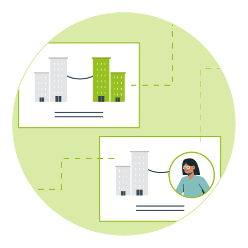B2B Content Marketing: A Comprehensive Guide
Here’s everything you need to know to start and succeed with a business-to-business content marketing strategy.

What Is B2B Content Marketing?
For companies in the business-to-business (B2B) space, there are many different ways to reach and engage potential clients. B2B content marketing is the process of presenting business decision-makers with different types of digital resources in order to raise brand awareness, promote products and services, and drive new and repeat business.
In many cases, B2B content offers thought leadership, industry insights and targeted solutions that directly relate to the audiences’ interests and pain points. With a strong B2B content marketing strategy in place, a company can expand its reach, become a known and trusted industry authority and ultimately set a strong foundation for new and ongoing client relationships.
Table of Contents
Part 1:
What Is B2B?
B2B is one of two primary business models that inform marketing strategy. In the B2B or business-to-business model, a company markets and sells its offerings to other companies. Often, these offerings are products, services and solutions that directly support business needs.
The other business model is business-to-consumer (B2C). In a B2C context, the company markets and sells its offerings directly to individual consumers.
Types of B2B companies
B2B companies come in all shapes and sizes, from small startups to global enterprises. The type of goods or services they sell informs how they market those offerings to other businesses.
A product-based B2B business provides other organizations with the physical products that they need to carry out their own business activities. This type of company might market consumable goods or equipment that companies in a certain industry rely on.
A service-based B2B business supplies services other companies need to keep their own operations running successfully. These types of services vary widely depending on industry needs, but can range from accounting to web development and beyond.
A software-based B2B business — also called a software-as-a-service (SaaS) business — simultaneously offers a product (the software itself) and a service (the management of the account). This type of company must market the value of the software itself, as well as service-related advantages like scalability and ongoing client support.
Part 2:
Understanding the B2B Buyer Journey
The B2B customer journey is significantly more complex than the B2C customer journey, largely because there are typically multiple stakeholders involved.
A B2C marketer only has to win over one consumer at a time. That individual conducts their own research, makes their own purchasing decisions and has control over the funds being put toward the product or service.
However, a B2B marketer may have to impress a whole cast of influencers and decision-makers within the company they’re targeting. They may use different types of content and different marketing messages to gain the interest and support of each person in the process.
B2B Buyer Roles
According to Gartner’s New B2B Buying Journey, this process tends to be non-linear and usually involves around 6 to 10 participants — all of whom perform several roles independently, and then must work together to reach an agreement.
Gartner identifies six distinct “jobs” stakeholders perform when seeking out B2B solutions:
- Problem identification: Pinpointing a need within the organization that initiates a search for B2B solutions.
- Solution exploration: Gathering information about the available products or services that could help meet that need.
- Requirements building: Establishing a wish list or checklist that states what the solution must accomplish.
- Supplier selection: Comparing different B2B vendors against the list of requirements.
- Validation: Confirming that the tentative choice is in fact the right one.
- Consensus creation: Getting all stakeholders and decision-makers to agree on how to proceed.
A B2B buyer may be near the end of this sequence, before presenting the solution to another team whose perspectives and decision-making process bring everyone right back to the beginning again.
For instance, the product development team may have established a consensus on what supplier they want to work with. But when legal, finance or IT gets involved, these new voices may introduce a new set of requirements the initial team was not aware of.
As a result, B2B marketers and sales teams must be prepared with a deep repository of content that can satisfy every question, concern and curiosity.
B2B Content Throughout the Sales Funnel
Despite the fact that the B2B buying journey often follows a labyrinthine path, it can still be organized into a chronological model known as the sales funnel.
Prospective buyers have different needs and intentions at each stage of the traditional B2B sales funnel — and various types of marketing content can serve different purposes along the way:
- Awareness: Prospects are just starting to gather information and are becoming aware of different B2B solutions providers. Content like blog posts and infographics help prospects get the high-level answers they’re looking for while building brand awareness.
- Interest: Once prospects know about a B2B business, they’re ready to learn more and be nurtured with content that appeals to their specific needs and interests. Email newsletters, eBooks, white papers and explainer videos can provide the deeper insights they’re looking for.
- Consideration: When prospects are ready to seriously consider a B2B company’s products or services, they want to know more about those offerings in detail, and whether they’re worth pursuing. Client case studies and testimonials provide social proof, while landing pages help address prospects’ specific questions at this stage.
- Decision: When it’s time for prospects to make the final purchasing decision, content that offers a deep-dive or a personalized perspective will help them make an informed choice. Product catalogs and demos are valuable tools.
- Loyalty: After the initial purchase, B2B companies can keep their clients informed, engaged and satisfied with resources that continue enriching the business relationship with added value. Video tutorials, service guides and other helpful content can help encourage retention.
Part 3:
B2B vs. B2C
Content Marketing
A look at the B2B buying journey shows that B2B marketers have a lot more stakeholder demands to satisfy than B2C marketers do.
As we’ve seen, a business-to-business company may need to impress nearly a dozen different stakeholders — all of whom have different motivations, priorities and needs — and help them establish consensus on the decision. In contrast, a business-to-consumer company just has to win over one individual consumer at a time.
B2B and B2C companies can use the same types of content and will often craft messages around things like value, trust and quality. But the differences between these business models have an impact on content marketing strategy and messaging emphasis.
Features of B2C Content Marketing
In general, B2C marketing tends to:
- Support a shorter, faster customer journey.
- Speak to audience members as individuals, often in relation to roles they play in their personal lives.
- Emphasize how the brand can resolve personal challenges and help consumers reach lifestyle goals.
- Use a conversational tone with more casual language.
- Tap into the emotional, desire-oriented side of the decision-making process.
Features of B2b Content Marketing
Although B2B content marketing certainly can do those things as well, it tends to:
- Support a longer, slower sales cycle.
- Speak to audience members on a professional level related to their role at the company.
- Emphasize how the brand can resolve work-related pain points and help the company reach its ultimate goals.
- Use a professional tone with industry-appropriate language.
- Speak to the practical, rational side of the decision-making process.
Despite these distinctions, it’s important for B2B marketers to remember that business audiences are also people. While content may appeal to their workplace identities and needs, they still have a sense of humor. Their emotions still play a role in the decision-making process. The most successful B2B content marketers can strike this balance.
Deep Dive
Business-to-Business (B2B) Marketing
B2B marketing refers to the techniques and best practices used by companies that sell directly to other businesses.
Business-to-Consumer (B2C) Marketing
B2C marketing is a very different animal compared with B2B strategies.
Part 4:
10 Benefits of B2B Content Marketing
Content plays an important role in a B2B business’s overarching marketing strategy. Here’s a look at 10 of the top benefits of B2B content marketing:
1. Allows Businesses To Speak Directly to Audience Members
Content created with prospects in mind gives companies the chance to directly address specific pain points and answer frequently asked questions.
2. Builds Brand Awareness for the Organization
When a business consistently puts out high-quality content across channels that are popular with its target audience, it has a better chance of standing out as a unique brand.
3. Establishes the Company as a Thought Leader
A legacy of great content positions the business and its employees as industry authorities and trustworthy advisors. The logical conclusion for prospects is that the brand’s products or services are sure to be as valuable as its insights.
4. Supports Prospects at Every Stage of the Sales Funnel
As we’ve seen, different types of marketing collateral can address a prospect’s questions or concerns, no matter where they are in the decision-making process.
5. Empowers Influencers To Present the Company to Decision-Makers
When employees find useful ideas or advice in a brand’s content marketing, there’s a chance they will bring that resource to the attention of their superiors, advocating for the brand and creating a positive first impression with decision-makers.
6. Generates Qualified Leads That Can Be Nurtured
Gated assets like eBooks, white papers and webinars provide businesses with the context and contact information they need to begin engaging those new prospects.
7. Gives Sales Reps Valuable Resources They Can Share With Prospects
When potential customers ask about ROI or industry experience, sales teams can leverage relevant content like case studies and industry-specific content campaigns, without delay.
8. Ensures Businesses Appear Ahead of Their Competitors in Search
A sophisticated B2B content marketing strategy can ensure the company owns high-value search terms and seizes search opportunities their competitors missed.
9. Drives More Online Traffic and Engagement
As part of a search engine marketing (SEM) strategy, great content can organically bring in new site visitors and boost engagement levels.
10. Allows Businesses To Seize Earned Media Attention and Widen Their Reach
The more great resources a company shares online, the more likely it is to be cited and referenced by other sources.
Part 5:
Characteristics of
Great B2B Content
Stellar content is integral to a successful B2B marketing strategy. After all, the quality of a company’s content marketing speaks volumes about the quality of its products or services.
Here are the hallmarks of high-quality B2B content:
High-Quality
From copywriting to graphic design, content marketing collateral should be polished and free of errors.
On Brand
In order for the company to reap the brand-boosting benefits of content marketing, every asset must be consistent and brand-aligned, from the tone of voice to the color palette and all the details in between.
Skimmable
Business leaders are busy and don’t often have time to read an entire resource cover to cover. Copy should be broken up with informative subheadings that convey the overall message while inviting readers to pause and focus on key topics.
Relevant
B2B content should not only be relevant to the target audience’s needs and pain points, it must also be created in support of the company’s own business objectives.
Consistent
Producing just one great eBook per year won’t help a B2B business grow. Instead, content should be produced and distributed at a regular cadence.
Accurate
The data points and facts presented in the content must all be truthful and free of errors or false assertions that could mislead B2B audiences and cause damage to either the company or its target audience.
Action-Oriented
Content should include a call-to-action (CTA) that urges audience members to take a next step, whether that’s filling out a form to request more information or calling the sales team to schedule a demo.
Part 6:
Best Types of Content For
B2B Audiences
Audience preferences, overarching business goals and campaign strategies will inform the content formats used in B2B marketing. Any form of written, visual or audio content that meets the above criteria can make a positive impression on business audiences.
Content that may resonate with a B2B audience includes:
- Blog posts that answer common questions.
- White papers that take a deep dive into an industry-related topic.
- Reports that showcase original research.
- eBooks that offer guidance or thought leadership.
- Guides that provide detailed explanations of processes or products.
- Infographics that visualize important data points or processes.
- Email newsletters that engage subscribers on timely, relevant matters.
- Landing pages that provide product and service information.
- Case studies that provide real-world examples and prove ROI.
- Client testimonials that speak to the company’s problem-solving capabilities.
- Video content that brings thought leadership and brand messages to life.
- Podcasts that present industry insights in an audio format.
- Webinars that educate, inspire and engage audience members.
- Social media posts that offer quick but valuable information.
Part 7:
Where To Promote B2B Content
Content creation isn’t where a B2B strategy ends. It’s important for businesses to promote those high-quality, high-value assets across channels where their target audiences will find them.
Search Engine Marketing
By creating search engine optimized (SEO) content, businesses can get their brand messages in front of audience members when they’re actively searching for information and solutions. Web content, like landing pages and blog articles, that are enriched with high-performing keywords and offer comprehensive coverage of those topics are well-positioned to land higher up in the search engine ranking pages (SERPs).
When selecting keywords to optimize for, search intent plays a critical role. Some keywords suggest informational intent, meaning people are looking for answers or to educate themselves on a topic. Any keyword like “what is X” or “how do you Y” implies informational intent.
Other keywords suggest commercial intent, meaning people searching those terms are seeking out solutions they can purchase. A keyword such as “best X for retail businesses” or “top Y in Chicago” indicates the searcher is looking for product or service recommendations that will meet their needs.
As part of an inbound marketing strategy, informative content like blog posts, eBooks and other gated assets can be optimized to attract audiences that are making inquiries with informational intent. Those searchers will find the answers they’re looking for while getting familiar with the brand. Meanwhile, product and service landing pages can be optimized to rank high in the SERPs for keywords that suggest commercial intent.
Email Marketing
B2B content marketers aren’t limited to SEM tactics — or to attracting net-new audiences. They can also take an outbound marketing approach and distribute content via email newsletters to existing contacts.
Segmenting audiences from within a company’s customer relationship management (CRM) system is an important step in tailoring email marketing campaigns so that they’re highly relevant to each group of audience members. For instance, a B2B marketer can use audience segmentation to email different pieces of content to warm leads, current clients and past clients.
social media Marketing
B2B content can perform well on social media if it’s promoted on the right channels. Business decision-makers often peruse LinkedIn for data points and industry insights, so sharing links to recent videos, infographics or white papers can drive up engagement. In some industries, social media platforms like Twitter, Instagram and Facebook may be just as widely used. It’s all about understanding the B2B audience and their social media habits, and a bit of market research can go a long way toward informing a social media content strategy.
The organization’s own social media accounts are great places to start when promoting B2B content. Encouraging employees and business partners to share as well can help expand a piece of content’s reach.
Deep Dive

6 Social Media KPIs for Social Media Marketing Mastery (Infographic + SlideShare)
There are numerous social media key performance indicators that you can track when evaluating your campaigns. Let’s look at six that really work, and some that aren’t worth monitoring.
Influencer Marketing
Using influencers to promote content, products and services isn’t restricted to the realm of B2C marketing. High-profile business leaders and key industry players can help amplify B2B content and build brand awareness among their audiences.
Partnering with familiar names in a given industry can provide opportunities for co-branded content. This can work whether the influencer is an entrepreneurial guru, an organizational leader at another company, or another business entirely.
One way to do this is to interview thought leaders on a podcast, blog or video. Another is to co-create an asset such as an eBook or webinar with another business. In both instances, the resource will get twice the exposure.
Employees can also function as influencers in B2B content marketing. Well-connected members of the staff can leverage their professional networks to boost their own authoritativeness while simultaneously promoting the company as a trusted thought leader. When employees present at industry events or speak to the press, they could promote a recent study or guide published by their employer.
Part 8:
How to Craft a B2B Content
Marketing Strategy
Whether you want to start a business-to-business content strategy from the ground up or fine-tune an existing plan, the path to success will follow many of the same steps. Here’s what you need to do:
Create Buyer Personas
After developing an understanding of the B2B buyer’s journey, creating buyer personas can show you what this journey specifically looks like for your own clientele — and what content will make the biggest impact every step of the way.
Gather insights through a combination of market research, conversations with the sales team and interviews with clients who represent your ideal buyer. Get to know what your target audience cares most about, what their main pain points and motivations are and how they make purchasing decisions. Find out where they go to look for answers, how they engage with content and what type of content and marketing messages they like most.
Write up a handful of profiles or bios that represent the key stakeholders and decision-makers you encounter during the sales process. Use these buyer personas to inform how you tailor your content strategy and marketing messages to each audience member.
Map Key Business Goals to Content Marketing Campaigns
Any content that doesn’t directly support overarching business goals is probably not worth creating. To ensure your B2B content marketing activities help drive growth, set goals for your campaigns that tie into key business goals.
Choose the types of digital marketing content that will help you achieve those goals. You might map different content marketing programs to different objectives throughout the year, or build one campaign designed to produce steady results.
Develop Research-Driven Content Ideas
Knowing your audience and your top business goals, you’re ready to begin brainstorming. Come up with content ideas and topics that will appeal to your B2B buyers. Complete market research to see what’s already out there and how you can differentiate your content. Conduct keyword research and evaluate search intent to fine-tune your approach.
If you have a healthy amount of existing resources, consider running a content audit to identify content gaps and missed opportunities. This can also help you pinpoint underperforming content that has the potential to be reoptimized.
Create a Plan for Content Production
Before finalizing the theme and direction of your B2B content marketing campaign, make sure you have the resources available to carry out the plan and create all of the content you’ve brainstormed.
Be realistic about the available time, budget and skills and how they’ll direct what you are capable of producing. For instance, a series of video testimonials might sound good on paper, but this could be challenging if you don’t have access to a trusted, experienced video team and the budget to support the project.
Whether you assign the work to in-house creatives, agency partners or a combination of both, confirm you have everything you need to bring your content goals to fruition before finalizing your strategy.
Determine Your Content Distribution Approach
Content creation for B2B isn’t the final step; you need a plan for how, where and when you’ll distribute that new content. Your content promotion plan could include a mix of email, social media, influencer or search engine marketing. However you decide to promote a piece of content, ensure your chosen channels make sense based on where your buyer personas and target audience will be looking.
Find ways to make the most of each new resource as well. One asset can be presented in different ways and at different times to engage new viewers. For instance, after the initial distribution of an eBook, that piece of collateral could be adapted into a blog post, webinar, explainer video, infographic or social media post.
Part 9:
Measuring the Success of a
B2B Content Marketing Strategy
After launching a B2B content marketing campaign, marketers and decision-makers need to understand its performance. Measuring a content strategy can help determine the ROI and impact of the current campaign, but the lessons learned can also inform future content marketing efforts.
Define What Success Means to You
The best and only way to really understand whether your content marketing strategy is working is to have a clear understanding of what a working strategy looks like for your business.
If you mapped your content strategy to key business goals, you should be able to pinpoint the indicators of content marketing success. For instance, an effective B2B strategy might mean expanding your reach and raising brand awareness among new audiences. Certain metrics related to your lead generation efforts can provide a glimpse into how you’re doing on this front.
But you might also be striving to optimize your workflows and reduce bottlenecks internally. Or, success might mean forging deeper relationships with your existing clients. In either case, you would be looking at very different KPIs to understand your strategy’s results.
Aligning your measurement tactics with your overarching goals will show you how you’re doing and where there are opportunities for improvement.
B2B Content Marketing Metrics
While the metrics you track will depend on your top goals, some valuable KPIs to observe include:
- Lead generation efforts.
- Organic traffic growth.
- Email subscribers.
- Backlinks from authoritative sources.
- Influencer performance.
- Engagement with web or social content.
- Form completion rates.
- Traffic sources.
Kick Off Your B2B Content Marketing Strategy Today
A solid B2B content marketing strategy can be instrumental in growing your brand, winning over new and existing clients and keeping your entire marketing team working together toward the same goal.
Whether you’re starting from scratch or overhauling your existing marketing efforts, the people you’re working with can make all the difference. Brafton’s full-service team of experienced content marketing strategists, SEO specialists, writers, animators, designers, email marketers, social media strategists, project managers and more can help bring all of your content marketing dreams to life.
With Brafton on your side, you’ll have a solid strategy and all the content you need to amplify your brand and grow your business.
The Content Marketer
Get the latest content marketing updates delivered directly to your inbox with our weekly newsletter.
































